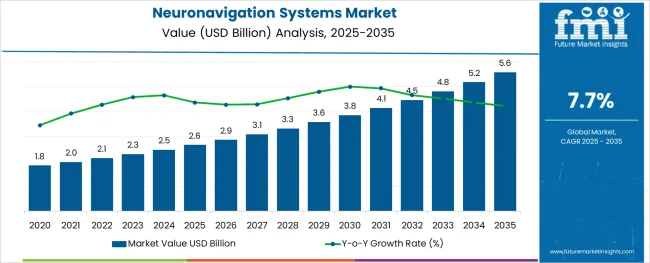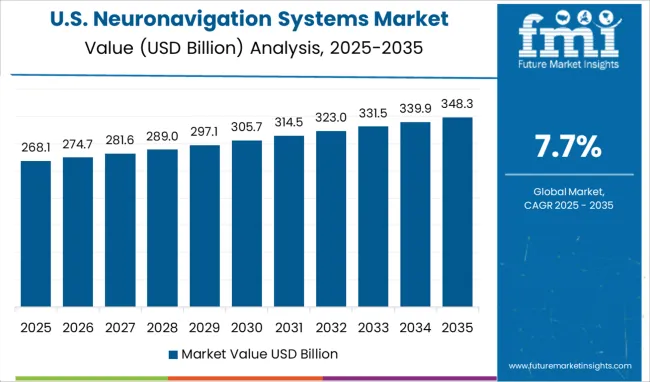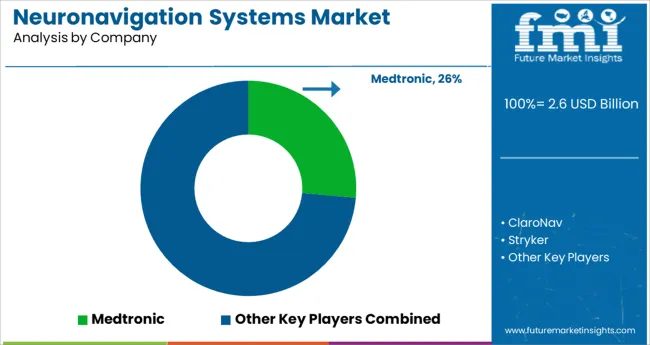The Neuronavigation Systems Market is estimated to be valued at USD 2.6 billion in 2025 and is projected to reach USD 5.6 billion by 2035, registering a compound annual growth rate (CAGR) of 7.7% over the forecast period.

The neuronavigation systems market is growing rapidly as advancements in surgical technology enhance the precision and safety of neurosurgical procedures. The demand for accurate real-time guidance during complex brain and spinal surgeries has increased significantly, improving patient outcomes and reducing operative risks.
Innovations in imaging and tracking technologies have expanded the capabilities of neuronavigation systems, enabling minimally invasive surgeries and better tumor localization. Healthcare providers have been investing in these systems to improve surgical accuracy and efficiency.
Additionally, the rising prevalence of neurological disorders and increasing numbers of neurosurgical interventions have supported market expansion. The future outlook remains positive with continuous development of hybrid navigation technologies and integration with robotic surgery platforms. Segmental growth is led by Optical Systems due to their superior tracking accuracy, Neurosurgery as the primary application, and Hospitals as the dominant end-user group.
The market is segmented by Type, Application, and End-Users and region. By Type, the market is divided into Optical System and Electromagnetic System. In terms of Application, the market is classified into Neurosurgery, ENT Surgery, Maxillofacial Surgery, and Spinal Surgery. Based on End-Users, the market is segmented into Hospitals, Ambulatory Surgery Centres, and Other. Regionally, the market is classified into North America, Latin America, Western Europe, Eastern Europe, Balkan & Baltic Countries, Russia & Belarus, Central Asia, East Asia, South Asia & Pacific, and the Middle East & Africa.

The Optical System segment is projected to hold 61.3% of the neuronavigation systems market revenue in 2025, retaining its dominance among technology types. The preference for optical systems has been driven by their high precision in tracking surgical instruments and real-time visualization capabilities.
Optical tracking offers non-invasive, radiation-free navigation, making it safer and more user-friendly in the operating room. Surgeons rely on optical systems for their accuracy in guiding delicate neurosurgical maneuvers, which reduces complications and improves recovery times.
These systems also integrate seamlessly with advanced imaging modalities, supporting complex procedures such as tumor resection and deep brain stimulation. As the demand for enhanced surgical accuracy continues, the Optical System segment is expected to remain the most adopted technology.

The Neurosurgery segment is expected to generate 53.7% of the market revenue in 2025, maintaining its lead as the primary application area for neuronavigation systems. This growth has been propelled by the increasing number of neurosurgical procedures worldwide driven by rising incidences of brain tumors, vascular disorders, and neurodegenerative diseases.
Neuronavigation systems enhance the surgeon’s ability to precisely target and remove abnormal tissues while preserving critical brain functions. The demand for minimally invasive neurosurgery techniques has further increased reliance on navigation systems to improve surgical outcomes and reduce patient trauma.
Continuous advancements in surgical techniques and growing investments in neurosurgical care infrastructure are expected to sustain the prominence of the Neurosurgery segment.

The Hospitals segment is projected to account for 68.5% of the neuronavigation systems market revenue in 2025, sustaining its position as the leading end-user. Hospitals are the primary centers for neurosurgical care due to their infrastructure, specialized surgical teams, and access to advanced technology.
Investments in upgrading surgical suites with neuronavigation systems have become a priority to meet rising patient demand and improve clinical outcomes. Hospitals also provide comprehensive care, including preoperative planning and postoperative monitoring, which leverages neuronavigation capabilities.
The presence of multidisciplinary teams and training programs has facilitated adoption and optimized use of these systems. As healthcare facilities expand neurosurgical services, the Hospitals segment is expected to maintain its dominant market share.
The demand for neuronavigation systems market is likely to witness growth due to high demand and increasing need for systems that are accurate.
One of the key neuronavigation systems market growth drivers of the global neuronavigation systems is the growing incidences of neurological disorders such as cancer, brain tumors, and stroke.
Moreover, other functionalities like planning of incision and craniotomy and determination of small subcortical lesions by neuronavigation systems are also driving the demand for neuronavigation systems in the global market.
In addition to that, there is an introduction to new and innovative neuronavigation systems by market players, which is fueling the demand and the adoption of these systems in the global market.
Furthermore, it is estimated that with the use of neuronavigation systems, there will be improved outcomes and shortened hospital stays that will motivate the neuronavigation systems market to increase.
Neuronavigation systems are also used for brain biopsy. Deep tumors inside the brains are dangerous and difficult to approach by open surgery, which can be diagnosed by passing the biopsy probe through a small hole in the skull. This method is used to place electrodes in the brain to treat disorders such as Parkinson’s disease. Neuronavigation system localization can limit the size of the opening of the skill, and it is estimated that these factors are likely to drive the neuronavigation systems market size in the upcoming years.
It is anticipated that clinical complications related to neuronavigation systems, combined with the high cost of acquisition and maintenance of these systems, are some of the major factors that would restrain the growth of the global neuronavigation systems market.
In addition to that, brain shift is a type of deformation of the brain during surgery due to gravity, the volume of a resected tumor, the intraoperative position of the patient, and loss of cerebrospinal fluid, which gives no accuracy in the preoperative images for the real-time anatomy which hinder the growth of the neuronavigation system market globally.

At present, North America holds the highest share of the neuronavigation systems market. This region is accountable for 44.9% of the total market share of neuronavigation systems.
Due to the high prevalence of neurological disorders and demand for technologically advanced neurological systems, this region has a bolstering growth in its neuronavigation market size.
In addition to that, government funding in this region for the development of surgical navigation systems and the rising adoption of minimally invasive surgery is fueling the growth of the neuronavigation systems market in the North American regions.

Europe is currently accountable for 26.1% of the total market share of neuronavigation systems. It is anticipated that Europe is emerging in the neuronavigation systems market due to the adoption of advanced technologies and the rising incidence rate of disorders.
Furthermore, there is a development of the healthcare infrastructure in the European regions, which is driving the market size for neuronavigation systems.
How are New Entrants Revolutionizing the Neuronavigation Systems Market?
The start-up ecosystem in the neuronavigation systems market is intense with frequent innovations being made. Start-ups in the neuronavigation systems market are focusing on improvising the tools for better implementation of surgical procedures.
Some of the new entrants in the market are - Happy Reliable Surgeries (HRS), which has emerged as the premier solution provider for neuro and ENT surgeries. HRS Navigation has many innovative tools which help surgeons to plan and execute surgery as per their plans. They are known to be a healthcare startup focused on providing innovative computer-assisted surgery solutions, HRS Navigation manufactures and markets high-tech surgical navigation systems.
The NeuroCare Group is a provider of neuromodulation and neurofeedback therapies for brain conditions. The company offers DC-EEG devices such as NEURO PRAX EEG, NEURO PRAX MR, and NEURO PRAX TMS/TES which are biofeedback systems. Also, offers transcranial electrical stimulation systems, transcranial magnetic stimulation, TMS neuronavigation, near-infrared spectroscopy, and others.

Who are some of the Key Market Players in the Neuronavigation Systems Market?
Some of the key players in the global neuronavigation system market are ClaroNav, Stryker, Brainlab AG, Parsis, Northern Digital Inc., Heal Force, Medtronic, Synaptive Medical, Bramsys Indústria e Comércio Ltd.
The key market payers are continuously making efforts to collaborate and create innovative technologies for the benefit of the patient, with standard and minimally invasive procedures for neurosurgeries and associated specialties.
Some of the key developments in the neuronavigation systems market are:
| Report Attribute | Details |
|---|---|
| Growth Rate | CAGR of 7.7% from 2025 to 2035 |
| Base Year for Estimation | 2024 |
| Historical Data | 2020 to 2024 |
| Forecast Period | 2025 to 2035 |
| Quantitative Units | Revenue in USD million and CAGR from 2025 to 2035 |
| Report Coverage | Revenue Forecast, Volume Forecast, Company Ranking, Competitive Landscape, Growth Factors, Trends and Pricing Analysis |
| Segments Covered | Type, Application, End User, Region |
| Regions Covered | North America; Latin America; Europe; East Asia; South Asia; Oceania; Middle East and Africa |
| Key Countries Profiled | USA, Canada, Brazil, Argentina, Germany, UK, France, Spain, Italy, Nordics, BENELUX, Australia & New Zealand, China, India, ASEAN, GCC, South Africa |
| Key Companies Profiled | ClaroNav; Stryker; Brainlab AG; Parsis; Northern Digital Inc.; Heal Force; Medtronic; Synaptive Medical; Bramsys Indústria e Comércio Ltd. |
| Customization | Available Upon Request |
The global neuronavigation systems market is estimated to be valued at USD 2.6 billion in 2025.
It is projected to reach USD 5.6 billion by 2035.
The market is expected to grow at a 7.7% CAGR between 2025 and 2035.
The key product types are optical system and electromagnetic system.
neurosurgery segment is expected to dominate with a 53.7% industry share in 2025.






Our Research Products

The "Full Research Suite" delivers actionable market intel, deep dives on markets or technologies, so clients act faster, cut risk, and unlock growth.

The Leaderboard benchmarks and ranks top vendors, classifying them as Established Leaders, Leading Challengers, or Disruptors & Challengers.

Locates where complements amplify value and substitutes erode it, forecasting net impact by horizon

We deliver granular, decision-grade intel: market sizing, 5-year forecasts, pricing, adoption, usage, revenue, and operational KPIs—plus competitor tracking, regulation, and value chains—across 60 countries broadly.

Spot the shifts before they hit your P&L. We track inflection points, adoption curves, pricing moves, and ecosystem plays to show where demand is heading, why it is changing, and what to do next across high-growth markets and disruptive tech

Real-time reads of user behavior. We track shifting priorities, perceptions of today’s and next-gen services, and provider experience, then pace how fast tech moves from trial to adoption, blending buyer, consumer, and channel inputs with social signals (#WhySwitch, #UX).

Partner with our analyst team to build a custom report designed around your business priorities. From analysing market trends to assessing competitors or crafting bespoke datasets, we tailor insights to your needs.
Supplier Intelligence
Discovery & Profiling
Capacity & Footprint
Performance & Risk
Compliance & Governance
Commercial Readiness
Who Supplies Whom
Scorecards & Shortlists
Playbooks & Docs
Category Intelligence
Definition & Scope
Demand & Use Cases
Cost Drivers
Market Structure
Supply Chain Map
Trade & Policy
Operating Norms
Deliverables
Buyer Intelligence
Account Basics
Spend & Scope
Procurement Model
Vendor Requirements
Terms & Policies
Entry Strategy
Pain Points & Triggers
Outputs
Pricing Analysis
Benchmarks
Trends
Should-Cost
Indexation
Landed Cost
Commercial Terms
Deliverables
Brand Analysis
Positioning & Value Prop
Share & Presence
Customer Evidence
Go-to-Market
Digital & Reputation
Compliance & Trust
KPIs & Gaps
Outputs
Full Research Suite comprises of:
Market outlook & trends analysis
Interviews & case studies
Strategic recommendations
Vendor profiles & capabilities analysis
5-year forecasts
8 regions and 60+ country-level data splits
Market segment data splits
12 months of continuous data updates
DELIVERED AS:
PDF EXCEL ONLINE
Systems Administration Management Tools Market Size and Share Forecast Outlook 2025 to 2035
VRF Systems Market Growth - Trends & Forecast 2025 to 2035
Cloud Systems Management Software Market Size and Share Forecast Outlook 2025 to 2035
Hi-Fi Systems Market Size and Share Forecast Outlook 2025 to 2035
Cough systems Market
Backpack Systems Market Size and Share Forecast Outlook 2025 to 2035
Unmanned Systems Market Analysis - Size, Share, & Forecast Outlook 2025 to 2035
DC Power Systems Market Trends - Growth, Demand & Forecast 2025 to 2035
Catheter Systems Market
Reporter Systems Market
Aerostat Systems Market
Cryogenic Systems Market Size and Share Forecast Outlook 2025 to 2035
Air Brake Systems Market Growth & Demand 2025 to 2035
Metrology Systems Market
Fluid Bed Systems Market
Cognitive Systems Spending Market Report – Growth & Forecast 2016-2026
Nurse Call Systems Market Insights - Size, Share & Forecast 2025 to 2035
Excitation Systems Market Analysis – Growth, Demand & Forecast 2025 to 2035
Fire Alarm Systems Market by Solution by Application & Region Forecast till 2035
Ultrasound Systems Market Growth – Trends & Forecast 2025-2035

Thank you!
You will receive an email from our Business Development Manager. Please be sure to check your SPAM/JUNK folder too.
Chat With
MaRIA